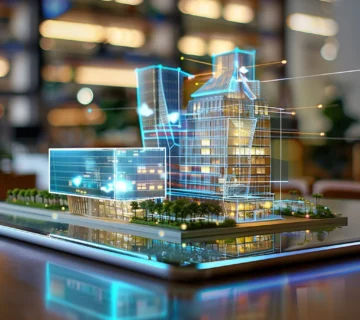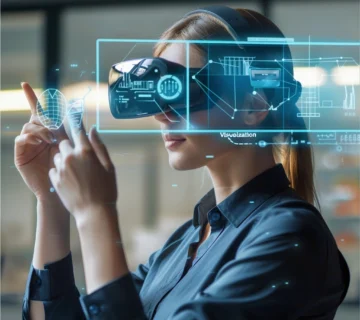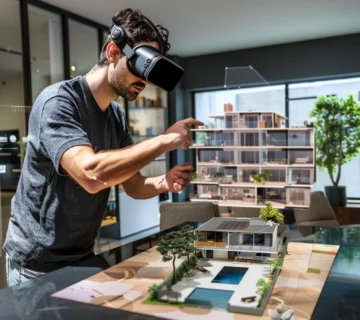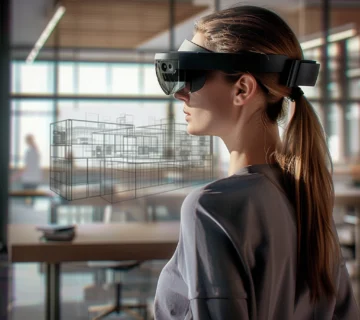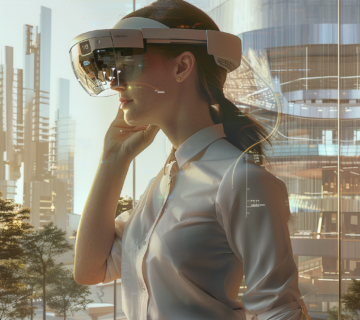The Best Decoding Augmented Reality Definition: Unveiling a 360° Displaying in 5 Key Points
Introduction:
The Augmented Reality Definition involves the real-time addition of 3D objects to the environment. “Augmented reality (AR) is the integration of digital information with the user’s environment in Real Time. Unlike virtual reality (VR), which creates a totally artificial environment, AR users experience a real-world environment with generated perceptual information overlaid on top of it.”[techtarget]
Augmented Reality (AR) stands at the forefront of technological innovation, offering a captivating interplay between the digital and physical dimensions. At its core, AR redefines our perception of reality by seamlessly integrating computer-generated elements into the real world in real-time. This transformative technology enriches the user experience through overlaid information, presenting a wealth of interactive 3D models, contextual data, and informative text that enhances understanding and utility.
The beauty of AR lies in its adaptability across diverse devices, from smartphones to specialized AR glasses, ensuring accessibility on various platforms. This adaptability not only expands the reach of Augmented Reality Definition applications but also opens doors to a multitude of possibilities, catering to a wide range of consumer, professional, and industrial needs.
Interactive user experiences form the heartbeat of AR, where users actively engage with the digitally enhanced environment. This hands-on approach allows users to manipulate virtual objects, navigate augmented landscapes, and interact with overlaid content, fostering a level of engagement that transcends traditional digital interactions.
The pervasive influence of AR extends beyond technological realms and infiltrates various industries. From healthcare and education to retail and manufacturing, Augmented Reality Definition finds applications that redefine processes and elevate experiences. Medical professionals utilize AR for surgical training, educators harness it for immersive learning, and retailers enhance customer engagement with virtual try-on features. This widespread integration underscores the transformative potential of AR in diverse domains, paving the way for innovative solutions and enriched experiences.
In unraveling the essence of Augmented Reality, these 5 key points serve as beacons, guiding us through a landscape where the digital seamlessly converges with the physical. Augmented Reality Definition emerges not only as a technological marvel but as a dynamic force reshaping our interaction with reality, setting the stage for a future where the boundaries between the virtual and real worlds continue to blur.
Augmented Reality (AR) has evolved into a transformative force, reshaping how we perceive and interact with the digital and physical worlds. Understanding the intricacies of the Augmented Reality Definition is crucial to navigating this dynamic landscape. In a comprehensive exploration, we unveil a 360° display of the core elements that define Augmented Reality, unraveling its essence in 5 key points.

Augmented Reality Definition: Unveiling the Fusion of Digital and Physical Realms in 5 Key Points
1. Real-Time Fusion:
At the core of Augmented Reality Definition lies the dynamic synergy between the digital and physical realms, achieved through real-time fusion. In contrast to virtual reality, which immerses users entirely in a simulated environment, Augmented Reality Definition elevates the existing reality by seamlessly incorporating computer-generated elements into the user’s immediate surroundings. This real-time integration is not confined to a separate digital space; instead, it unfolds within the user’s immediate environment, creating a captivating experience where the boundaries between the virtual and real worlds dissolve.
This instantaneous fusion results in a dynamic and fluid interaction, presenting users with a spectrum of possibilities for immersive and interactive engagement. Augmented Reality, thus, emerges as a bridge connecting the tangible and the digital, transforming the way we perceive and interact with our surroundings in a way that is both seamless and transformative.
In essence, Augmented Reality (AR) acts as a transformative bridge, seamlessly connecting the tangible world with the digital realm. This transformative quality redefines how we perceive and interact with our surroundings, marking a paradigm shift in our relationship with the environment.
By overlaying digital elements onto the physical world, AR enhances the tangible reality we experience daily. This seamless integration bridges the gap between what is physically present and what is digitally generated, creating a cohesive and harmonious blend. Users can witness the convergence of these two realms in real-time, leading to an enriched and multi-dimensional experience.
The transformative power of AR lies in its ability to break down traditional barriers, for example in architecture realm Exterior & interior visualizing in AR, allowing individuals to interact with digital content in a contextually relevant manner. It turns passive observation into active engagement, where the digital augmentation becomes an organic part of the user’s perception. This dynamic integration not only enhances the richness of experiences but also opens up new possibilities for education, entertainment, communication, and myriad other fields.
As AR continues to evolve, it reinforces the notion that the digital and tangible worlds are not mutually exclusive but interconnected facets of our reality. This seamless connection reshapes our understanding of the environment, making the interaction between the physical and digital realms a natural and integral part of our everyday lives.
2. Overlaid Information:
Augmented Reality Definition transcends mere visual enhancements by introducing the innovative concept of overlaid information. This transformative feature extends beyond the traditional scope of visual embellishments, bringing a layer of digital information to the user’s real-world perception. Whether it takes the form of informative text, interactive 3D models, or contextual data, Augmented Reality seamlessly overlays these digital elements onto the user’s immediate surroundings.
This dynamic layering process serves as a powerful tool, enriching the user’s understanding of their environment by providing a depth of information that goes beyond what the naked eye perceives. Imagine walking through a historical site and having relevant historical facts appear, or exploring a city and receiving real-time information about nearby points of interest. This fusion of digital and physical information not only enhances the utility of Augmented Reality Definition but also elevates the comprehension of the user, offering an immersive and informative experience that goes beyond the surface level of the physical world.
Consider the scenario of strolling through a historical site enriched by Augmented Reality (AR). As you navigate the cobblestone paths, your device or AR glasses seamlessly integrate relevant historical facts onto the real-world landscape. The once-static monuments come to life with additional layers of information, providing context, stories, and historical significance. Each step becomes a journey through time, where the digital augmentation enhances the tangible environment, turning a conventional visit into an immersive historical expedition.
Similarly, when exploring a city with AR, real-time information about nearby points of interest becomes instantly accessible. Imagine standing in front of a landmark, and your device or AR glasses deliver engaging details about its architecture, historical anecdotes, and cultural significance. As you move through the city, the digital layer adapts, offering insights into restaurants, art installations, or events happening around you.
This fusion of digital and physical information creates a dynamic and personalized experience, enriching your comprehension of the surroundings and transforming your exploration into an interactive and educational journey that transcends the surface level of the physical world. Augmented Reality not only augments utility but becomes a gateway to a deeper, more informed understanding of the environment, making every encounter a blend of discovery and immersion.
3. Device Diversity:
The versatility of Augmented Reality (AR) is exemplified by its seamless compatibility across a spectrum of devices. Augmented Reality Definition extends its reach from the familiar landscape of smartphones and tablets to the more specialized realm of AR glasses. This adaptability ensures widespread accessibility, as users can engage with Augmented Reality Definition experiences using the devices they already own or opt for more immersive encounters through dedicated AR hardware like glasses.
This adaptability is not merely a technological feat; it serves as a gateway to diverse applications spanning various sectors. From consumer-oriented experiences that enhance daily interactions to professional applications in fields like architecture, healthcare, and education, AR’s flexibility opens avenues for innovation. The technology becomes a transformative tool in industrial settings, aiding in training, maintenance, and complex task execution. Whether in the hands of a consumer exploring augmented realities on a smartphone or an industry professional utilizing AR glasses for intricate tasks, the versatility of AR broadens its user base and amplifies its potential across a rich tapestry of applications, underscoring its capacity to enhance experiences in both everyday life and specialized domains.
Augmented Reality (AR) definition encapsulates a versatile technology that transcends boundaries, making it accessible and impactful across a diverse spectrum of applications. In the consumer realm, individuals wielding smartphones embark on augmented realities, unlocking immersive experiences that seamlessly blend the digital and physical worlds. Whether virtually trying on clothes, visualizing furniture in a living space, or engaging in interactive games, AR becomes an everyday companion, enhancing mundane activities with a layer of digital augmentation.
On the professional front, the adaptability of Augmented Reality Definition extends to specialized hardware like AR glasses. Industry professionals, such as engineers, architects, and medical practitioners, harness the power of AR to execute intricate tasks with precision. From visualizing complex 3D models in architectural design to utilizing AR-assisted surgeries in healthcare, the technology becomes an indispensable tool, amplifying efficiency and accuracy in specialized domains.
The versatility of AR not only caters to the curiosity of consumers but also revolutionizes processes and workflows in professional sectors. This broad applicability underscores AR’s potential to enhance experiences in both everyday life and specialized domains, marking it as a transformative force with a capacity to shape the future of digital interactions and redefine how we perceive and engage with our surroundings.
4. Interactive User Experience:
At the heart of Augmented Reality (AR) lies a profound emphasis on crafting interactive user experiences, fundamentally reshaping the traditional dynamics of user engagement. Unlike passive observation, Augmented Reality Definition positions users as active participants within a digitally enhanced environment. This transformative approach empowers users to go beyond mere observation and become hands-on contributors to the augmented landscape.
AR facilitates this heightened level of engagement by providing users with the capability to manipulate virtual objects in real time. Whether it’s virtually placing furniture in a room, exploring 3D models, or interacting with informative overlays, users have the agency to shape their augmented surroundings. The technology extends beyond static visuals, inviting users to navigate augmented landscapes, essentially merging the physical and digital realms seamlessly.
The interactivity within AR experiences goes beyond superficial engagement, creating an immersive environment where users interact with overlaid content organically. This dynamic interaction elevates the user’s involvement to a level where the digital augmentation isn’t a mere embellishment but an integral and essential component of the overall experience. In this paradigm, AR transforms users from passive spectators to active contributors, fostering a symbiotic relationship between the user and the augmented environment, and enhancing the overall quality and depth of the digital experience.

5. Integration Across Industries:
The far-reaching influence of Augmented Reality (AR) permeates across a diverse spectrum of industries, illustrating its transformative potential and adaptability in varied domains. In the healthcare sector, medical professionals harness Augmented Reality Definition for revolutionary applications such as surgical training, where intricate procedures can be simulated in a risk-free virtual environment, allowing practitioners to enhance their skills and refine their techniques.
Education is another domain where Augmented Reality Definition unfolds its transformative capabilities. Educators leverage AR to create immersive learning experiences that go beyond traditional methods, bringing subjects to life and making complex concepts more tangible and accessible to students.
In the retail landscape, Augmented Reality Definition is a game-changer, offering innovative features like virtual try-on experiences. Customers can virtually visualize products, such as clothing or accessories, before making a purchase, enhancing the online shopping experience and reducing the need for physical trials.
Moreover, AR’s integration extends to manufacturing, where it streamlines processes such as prototyping and assembly. This technology aids in Augmented reality design complex components, providing valuable insights for design and manufacturing teams.
The wide-ranging applications of Augmented Reality Definition underscore its adaptability, making it a transformative force that transcends industry boundaries. As industries continue to explore and implement Augmented Reality Definition solutions, the technology’s potential to revolutionize diverse sectors becomes increasingly evident, marking it as a key player in the evolution of digital experiences across various domains.
In decoding the Augmented Reality Definition, these 5 key points serve as the compass, guiding us through the multifaceted landscape of a technology that not only enhances our reality but also redefines how we interact with the digital realm. As we unveil the 360° display of Augmented Reality Definition, we gain a holistic perspective on its essence, applications, and the boundless possibilities it holds for the future.

Conclusion:
In conclusion, Augmented Reality Definition emerges as a groundbreaking technology that seamlessly integrates digital elements into our physical reality, offering a transformative bridge between the tangible and the digital. Its versatility is exemplified by its widespread accessibility, catering to both consumers exploring everyday augmented experiences on smartphones and professionals utilizing specialized AR glasses for intricate tasks.
AR’s impact extends across diverse industries, from healthcare and education to retail and manufacturing, showcasing its capacity to revolutionize processes and workflows in specialized domains. The dynamic fusion of digital and physical information not only enhances utility but elevates the comprehension of users, providing immersive and informative experiences that transcend the surface level of the physical world, for example Augmented reality in architecture or Augmented reality in construction or Augmented reality in building can be the example of AR in physical world.
As AR continues to evolve, its user-centric design philosophy ensures that interactions are not only seamless but also tailored to individual needs. The technology’s ability to create interactive and personalized experiences signifies a paradigm shift in how we engage with our environment.
Ultimately, Augmented Reality Definition stands at the forefront of innovation, promising to shape the future of digital experiences and redefine our relationship with technology. It’s a tool that goes beyond embellishing visuals; it empowers users to actively participate in a digitally enhanced reality, making every encounter a blend of discovery, immersion, and transformation.



